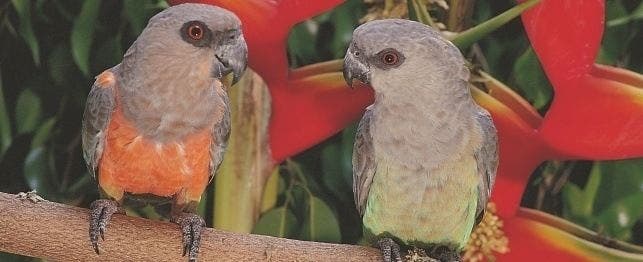
Choosing a Red-bellied Parrot
Red-bellies are playful outgoing birds. These birds love attention, but don’t demand it, especially as they grow older. They tend to become more independent as they reach sexual maturity. Although generally sweet birds, adult males may become aggressive during breeding season. While they are not great talkers, they have some limited mimicking ability.
Red-bellied parrots(Poicephalus rufiventris) are found in eastern Africa (Tanzania, Kenya, Ethiopia and Somalia) inhabiting semi-arid forests. Wild birds are generally found in pairs or small groups and are shy and wary.
Red-bellied parrots can live up to approximately 30 years but more likely approximately 15 to 20 years.
Appearance and Personality
Red-bellied parrots are small stocky parrots, one of the smallest Poicephalus. You can easily tell the sexes apart. The male has a deep orange belly patch and under-wing patches; the female has a blue green body color. The head, neck and upper chest is gray-brown, tail and flight feathers are gray and rump is blue.
Young red-bellies adapt readily to new surroundings and should be well adapted to many novel experiences at a young age. Adult birds are less adaptable to unfamiliar environments, dietary changes.
Red-bellied are very playful and energetic. Environmental enrichment is important. They should always be provided with toys, wooden blocks that can be chewed, and branches from non-toxic trees. In order to ensure safety, companion birds should not be allowed unsupervised freedom in the home as they often encounter toxins or dangerous items. Young birds should be socialized to many people and exposed to a variety of situations such as new cages, toys, visits to the veterinarian, handling by friends, wing and nail clips, etc. to avoid fear of novel situations.
Feeding
Red-bellied parrots, as well as African greys, appear to utilize calcium differently than other psittacine species. Birds kept as indoor pets especially tend to develop signs of calcium deficiency that can be a serious health threat. Natural or full spectrum light may also be helpful. African parrots should be fed a formulated (pelleted or extruded) diet as a basis for good nutrition. Red-bellied should be fed approximately 1 heaping tablespoon of pellets daily.
The diet should be supplemented with approximately the same quantity of fresh fruits and vegetables daily to add variety and psychological enrichment. Treats may be given in small amounts especially as rewards for good behavior. Fresh clean water must be provided every day. Vitamin supplements are not needed for birds that are eating a formulated diet.
Poicephalus are very difficult to hand-rear from the egg and ideally should be parent fed for the first 1 to 2 weeks of life or they must be fed very often. They will wean or fledge at approximately 7 to 9 weeks of age.
Grooming
Routine bathing or showering is vital to maintaining good plumage and skin condition. Birds can be misted and allowed to dry in a warm room or in the sun, or dried with a blow drier. Care should be taken not to clip the wing feathers excessively as heavy bodied birds may fall and injure themselves. Clip only enough so the bird will glide to the floor.
Housing
African parrots are very active and should be provided with as large a cage as possible. The cage should have two perches so the birds can move between them. Cage size should be at least 4 feet by 4 feet by 4 feet or 3 feet by 3 feet by 6 feet. Toys and activities should be provided. Ideally pet birds should have a cage outdoors to allow exposure to sunlight and fresh air in good weather.
Breeding
Red-bellied parrots breed well in captivity. Some prolific birds will breed year round but most breed in the winter and early spring. Clutch size is usually 3 to 4 eggs.
For a nest box, red-bellies will use a vertical 10-inch by 10-inch by 12-inch or an L shaped box.
Common Diseases and Disorders
Red-bellied parrots are relatively healthy birds but are susceptible to the following:
- Chlamydiosis (Psittacosis)
- Psittacine Beak and Feather Disease
- Feather picking
- Respiratory Diseases- Aspergillosis
- Bacterial, viral, Fungal Diseases
- Calcium deficiency disorder
- Toxicities